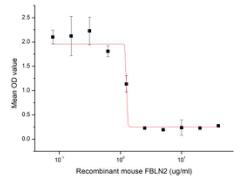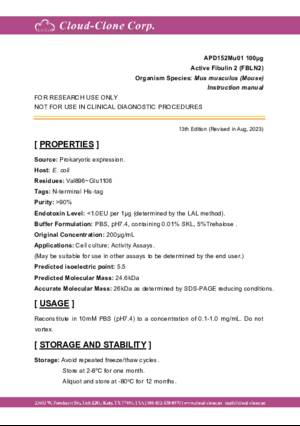Active Fibulin 2 (FBLN2)
FIBL-2
- Product No.APD152Mu01
- Organism SpeciesMus musculus (Mouse) Same name, Different species.
- Buffer FormulationPBS, pH7.4, containing 0.01% SKL, 5% Trehalose.
- Traits Freeze-dried powder
- Purity> 90%
- Isoelectric Point5.5
- ApplicationsCell culture; Activity Assays.
- DownloadInstruction Manual
- UOM 10µg50µg 200µg 1mg 5mg
- FOB
US$ 216
US$ 540
US$ 1080
US$ 3240
US$ 8100
For more details, please contact local distributors!
ACTIVITY TEST

Fibulin 2 (FBLN2) is the second largest member of the seven-member fibulin family of extracellular membrane (ECM) glycoproteins. The protein is known to form disulfide-linked homodimers, but it can also be secreted as an oligomer. Fibulin 2 is considered a multifunctional binding protein due to its association with numerous ECM components, but its specific interactions have yet to be determined. Fibulin 2 is localized at the interface between microfibrils and the elastin core and its known interactions include nidogen-1, perlecan, laminin, aggrecan, endostatins, versican, collagen, and tropoelastin. It is down-regulated in numerous forms of cancer including breast, colorectal, lung, esophageal, and squamous cell carcinoma, but over-expression has been shown with solid tumors. To test the effect of FBLN2 on cell apoptosis, A549 cells were seeded into triplicate wells of 96-well plates at a density of 4,000 cells/well and allowed to attach overnight, then the medium was replaced with various concentrations of recombinant mouse FBLN2 diluted with 5% serum standard DMEM. After incubated for 72h, cells were observed by inverted microscope and cell proliferation was measured by Cell Counting Kit-8 (CCK-8). Briefly, 10 µl of CCK-8 solution was added to each well of the plate, then the absorbance at 450 nm was measured using a microplate reader after incubating the plate for 1h at 37℃. Proliferation of A549 cells after incubation with FBLN2 for 72h observed by inverted microscope was shown in Figure 1. Cell viability was assessed by CCK-8 (Cell Counting Kit-8 ) assay after incubation with recombinant mouse FBLN2 for 72h. The result was shown in Figure 2. It was obvious that FBLN2 significantly inhibit cell viability of A549 cells. The ED50 is 1.25 μg/mL.

Figure 2. Inhibition of A549 cells proliferation after stimulated with FBLN2.
USAGE
Reconstitute in 10mM PBS (pH7.4) to a concentration of 0.1-1.0 mg/mL. Do not vortex.
STORAGE
Avoid repeated freeze/thaw cycles. Store at 2-8°C for one month. Aliquot and store at -80°C for 12 months.
STABILITY
The thermal stability is described by the loss rate. The loss rate was determined by accelerated thermal degradation test, that is, incubate the protein at 37°C for 48h, and no obvious degradation and precipitation were observed. The loss rate is less than 5% within the expiration date under appropriate storage condition.
GIVEAWAYS
INCREMENT SERVICES
-
 BCA Protein Quantification Kit
BCA Protein Quantification Kit
-
 Molecular Mass Marker for Protein
Molecular Mass Marker for Protein
-
 Monoclonal Antibody Customized Service
Monoclonal Antibody Customized Service
-
 Polyclonal Antibody Customized Service
Polyclonal Antibody Customized Service
-
 Protein Activity Test Experiment Service
Protein Activity Test Experiment Service
-
 Electrophoretic Mobility Shift Assay (EMSA) Experiment Service
Electrophoretic Mobility Shift Assay (EMSA) Experiment Service
-
 Buffer
Buffer
-
 Lentivirus Packaging Experiment Service
Lentivirus Packaging Experiment Service
-
 Adenovirus Packaging Experiment Service
Adenovirus Packaging Experiment Service
-
 Real Time PCR Experimental Service
Real Time PCR Experimental Service
-
 Spike RBD Protein (S-RBD)
Spike RBD Protein (S-RBD)
-
 Protein G
Protein G
-
 Protein A
Protein A
| Magazine | Citations |
| PLoS One | Simvastatin Increases Fibulin-2 Expression in Human Coronary Artery Smooth Muscle Cells via RhoA/Rho-Kinase Signaling Pathway Inhibition PubMed: 26207907 |
| Catalog No. | Related products for research use of Mus musculus (Mouse) Organism species | Applications (RESEARCH USE ONLY!) |
| RPD152Mu01 | Recombinant Fibulin 2 (FBLN2) | Positive Control; Immunogen; SDS-PAGE; WB. |
| APD152Mu01 | Active Fibulin 2 (FBLN2) | Cell culture; Activity Assays. |
| RPD152Mu02 | Recombinant Fibulin 2 (FBLN2) | Positive Control; Immunogen; SDS-PAGE; WB. |
| PAD152Mu02 | Polyclonal Antibody to Fibulin 2 (FBLN2) | WB; IHC; ICC; IP. |
| PAD152Mu01 | Polyclonal Antibody to Fibulin 2 (FBLN2) | WB; IHC; ICC; IP. |
| SED152Mu | ELISA Kit for Fibulin 2 (FBLN2) | Enzyme-linked immunosorbent assay for Antigen Detection. |
| LMD152Mu | Multiplex Assay Kit for Fibulin 2 (FBLN2) ,etc. by FLIA (Flow Luminescence Immunoassay) | FLIA Kit for Antigen Detection. |
| KSD152Mu01 | ELISA Kit DIY Materials for Fibulin 2 (FBLN2) | Main materials for "Do It(ELISA Kit) Yourself" |







